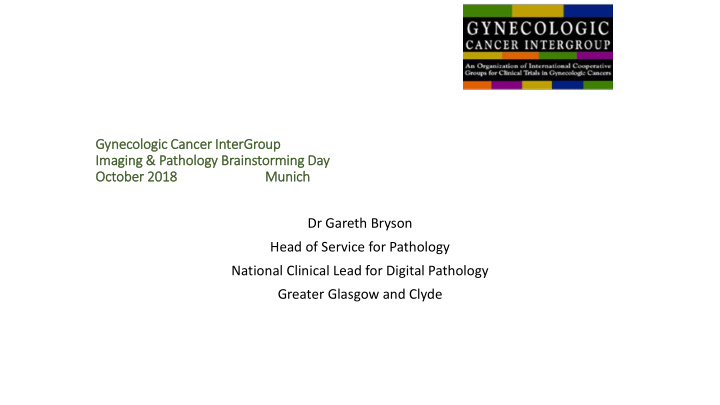



Gynecologic Ca Cancer In Inter erGroup Im Imaging & Path thology Br Brain instormin ing Da Day Oct ctober 2018 M Munich Dr Gareth Bryson Head of Service for Pathology National Clinical Lead for Digital Pathology Greater Glasgow and Clyde
Disclaimer (Commercial) • NHS Greater Glasgow and Clyde are a customer of Philips Digital Pathology • I receive no payment from Philips
Disclaimer (Academic) • I am a Pathologist • I am not a • Mathematician • Data scientist • Computer scientist
Precision Medicine (Diagnostics)
Digital Pathology • Historical • Low volume specialist services • Intra-operative examinations • Over the last 2-3 years • Move towards a fully digital workflow • Up to 12% productivity gains • Ability to safely uncouple technical productions and medical reporting • Ability to move reporting to areas of stable capacity
Challenges for Digital Pathology Data Magnification
Google Maps and Digital Pathology • Zoom and pan technology developed for google maps underpins digital pathology. • Whole slide image data is huge but data streamed in routine viewing is only a fraction (about 5%). • For example you don’t download a map of the world to find your way with Google maps.
Data Comparisons Radiology PACS Digital Pathology • 60 MB Uncompressed per study • 1.2 GB per slide • 1MB compressed • 7 GB per request • In 10 years, just reached 1 PB • In 5 years, anticipating at least 5 (1000 TB) PB • Won’t reach steady state until 10-15 years Overall, data requirements are up to 20 x higher.
Drivers for Digitisation • Currently NHS Scotland manages 2 million glass slides per year • Digitisation has been shown to improve efficiency – up to 12% • Security and accessibility of archive • Enables innovative models of working • Cross boundary work sharing • Working off site (other hot site or home) • Improved ergonomics
The Facts….. • 8% Consultant vacancy rate in Scotland • 15% UK • Brexit • UK – 32% Consultants are over 55 • Most to retire within 5 years • Approximately 120 per year • Approximately 50 Trainees qualifying per year • 70 shortfall per year • 20-30 training posts unfilled
More Facts….. • Annual increase in demand – 4.5% • 2-3% in Scotland • UK Cancer incidence – up 7% in 10 years • Scotland 12% • 25% increase predicted by 2027 • Demographic shifts • More cancer survivors
And Worse Facts….. • More MDT meetings • Explosion of RCPath Datasets • 63 Cancer Datasets or tissue pathways • And complexity of each one • Mainstreaming of molecular pathology • Reflex • Adjuvant • Clinical trials • Molecular MDTs and integrated reporting
Pathology Services • 10-12% efficiency gain welcomed • But will not be sufficient for sustainability
Signal Receiver Message
Message
Receiver Limitations • Excellent pattern recognition • Moderately accurate measurements • Poor quantification • Often just moderate consistency in diagnosis and grading
Signal
• Image is pictoral expression of • Genomics • Transcriptomics • Proteomics Signal • Environment • Context • Time
Receiver Message Signal
Digitally Augmented Pathology
Deep learning
Multi-stranded diagnostic data 1. Pathology 2. Radiology 3. Genomics 4. Transcriptomics 5. Proteomics
The missing piece of the jigsaw DATA AI
Future Diagnostics • Integration of diverse data sources by AI • Pathology Report data • Pathology pixel data • Molecular data • Clinical data • Radiology data • Use of machine/deep learning to compare this integrated data to patient outcomes and identify patterns for predicting outcome of future patient cohorts.
Opportunities in Cervical Pathology • Tumour volume as predictors of lymph node metastasis • Ability to count tumour cells
Opportunities in Endometrial Pathology • Image analysis can measure • Mean nuclear size • Nuclear variation • Glandular percentage • Nuclear density • Epithelial density
Opportunities in Ovarian Pathology • Association of TIL with clinical outcome • More consistent scoring with image analysis of immunostained sections
Role for Clinical Trial Group • Custodians of datasets and images to mine for enhanced diagnostic features • Implement next generation diagnostics into clinical trials to accurately stratify patients based on morphological and molecular characteristics • Use digital pathology methods for accurate implementation of companion diagnostics
Conclusions 1. Digital pathology (as a way for pathologists to view images has benefits and is worth doing) 2. Pathology image data is important, and not fully utilised 3. Unlocking the full benefits will require Image Analysis and AI 4. AI is key to future diagnostics integrating pathology and omics data 5. Clinical trials should engage with pathologists to ensure consistent patient selection and stratification for eaningful results
Recommend
More recommend